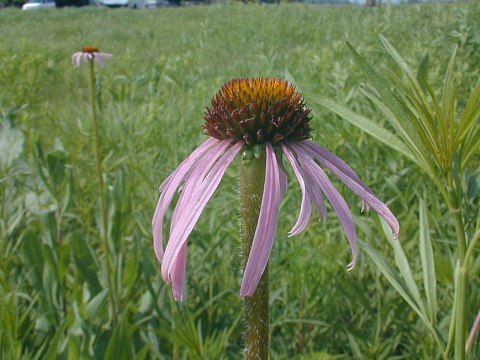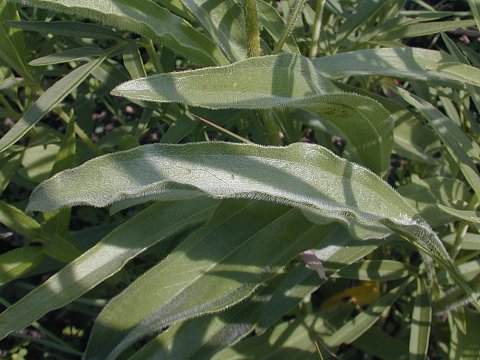Description: This herbaceous perennial plant is up to 3' tall and unbranched. The stout central stem is greyish or reddish green and covered with coarse white hairs. Most of the leaves occur near the base of the plant, although a few of them alternate along the lower 1/3 of the stem. They are up to 9" long and 2" across, and narrowly lanceolate, oblanceolate, or ovate. The margins are smooth, but often curl upward, while the upper and lower surfaces of the leaves are covered with fine white hairs. Leaf venation is primarily parallel, although a few fine pinnate veins may be present.

A single
daisy-like composite flower develops at the top of the stem. It is
about 3" across, consisting of a prominent reddish brown cone of disk
florets, which are surrounded by 12-20 light purple ray florets. The
ray florets are long, slender, and droop downward. There is no
noticeable floral scent. The blooming period occurs during early summer
and lasts about 3 weeks, after which the ray florets shrivel away and
the central cone turns black. The achenes are without tufts of hair.
The root system consists of a stout taproot.
Cultivation:
The preference is full sun and average to dry conditions. The soil can
contain loam, clay, or rocky material. There is a tendency for Pale
Purple Coneflower to flop over when in bloom if it is pampered by too
much water or lacks adequate support from adajacent vegetation. It
doesn't seem to be bothered much by disease, and withstands drought
very well. Development is slow unless ample sunlight is received. This
plant can fail to survive the winter if the central taproot is not
covered with sufficient soil.
Range & Habitat:
Pale Purple Coneflower occurs occasionally throughout Illinois, except
in some of the southern counties (see Distribution
Map). It is native to Illinois. Habitats include mesic to dry
black soil prairies,
openings in dry rocky woods, Oak savannas, limestone glades, abandoned
fields, and open areas along railroads. It is possible that this plant
occurred in gravel or dolomite prairies before these habitats were
largely destroyed by development.

Faunal
Associations:
Long-tongued bees, butterflies, and skippers are the most important
visitors to the flowers. Among the long-tongued bees, are such visitors
as bumblebees, Nomadine cuckoo bees, large carpenter bees, and
leaf-cutting bees. Short-tongued green metallic bees and other
Halictine bees also visit the flowers occasionally. The caterpillars of
the butterfly Chlosyne nycteis (Silvery
Checkerspot) feed on the foliage, while caterpillars of the
moths Synchlora aerata
(Wavy-Lined Emerald) and Eupithecia miserulata
(Common Eupithecia) feed on the flowerheads. Goldfinches occasionally
eat the seeds. Mammalian
herbivores, particularly livestock, may eat this plant occasionally,
but it is not a preferred food source.
Photographic Location:
The photographs were taken at the Red Bison Railroad Prairie in Savoy,
Illinois.
Comments:
This plant usually precedes Echinacea purpurea
(Purple Coneflower) in bloom by about 2-4 weeks. Sometimes their
flowers are difficult to tell apart, but the leaves of Pale Purple
Coneflower are more long and narrow, hairier, lighter green, and tend
to remain near the base of the plant.